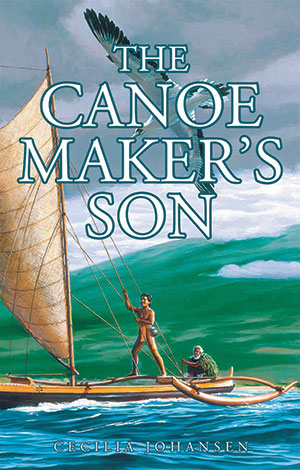Ka Puana: The Canoe Maker’s Son
Author Cecilia Johansen is a Waimea, Hawai‘i Island resident.
 These excerpts are used with permission.
These excerpts are used with permission.
Page 31
Nāihe was well-respected from Kaimū all the way to ‘Āpua. However, the men would not offend him by saying they had already seen the runner. King Kalani‘ōpu‘u’s runners, wearing malo, were famous for being able to run flat out so their loincloth would shoot straight out behind them.
When the men and their sons reached the beautiful black sand beach of Kalapana, all the people living nearby were assembled. The crowd included family heads of the ahupua‘a from Poupou, Kamoamoa, Kahauale‘a, Kapa‘ahu, Kalapana, and Kaimū2 and stood on the sandy beach or floated in canoes on the water.
‘Eleu never paid attention to what people looked like, and quite suddenly, he was aware of his father’s appearance. Kanewa was his name—the war club. It seemed an odd thing to be called, but his father was a tall strong man with very large hands. “Sort of club-like, I guess,” he thought to himself, wrinkling his nose. Hands like that would be desired in his profession.
His father was an expert with the adze of all sizes and could flake great large pieces as well as the most delicate of pieces from koa logs of which the canoes were made.
He was able to hew out a log faster than any other canoe makers in the district, which made him a favorite of the local chiefs. With that last canoe of the fleet done in record time, he would be the favorite of the great chief Kalani‘ōpu‘u.

‘Eleu noticed how the people respected his father, and when it came time to remove the canoe from its halau wa‘a, the long house built to protect it, the boy immediately felt pride that he was the canoe maker’s son—a new feeling for the young boy of five years old.
2. Except for Kalapana, these ahupua‘a have not survived due to lava flow.
Page 78
One early morning, royal messengers came to Pāwa‘a to request some men, especially ‘Eleu and Waipā, who would be going to the navy yard at Kealakekua. ‘Eleu recognized two of those men who came for him at Waimanalo. He agonized over the turn of events. There was no time to get word to his family. Somehow, he must let them know where he was going.
Work at the bay on Hawai‘i Island was the same. Hundreds of logs had their cores removed and the pepeiao gouged out inside at intervals. Seats fitted with the was underneath would prevent the hull from twisting. Those seats would hold two paddlers each. With the addition of the platform between the hulls, the combined carrying capacity of the peleleu could easily be two hundred forty paddler-warriors plus gear. The sails made of canvas were attached to ‘ōhi‘a lehua masts, resembling the schooners that came to the islands. The new sailing vessels were called wa‘a peleleu, the large war canoes for Kamehameha’s approaching invasion.
‘Eleu was good at all the canoesʻ lashing with ‘aha. Beside his duties of finishing hulls, he was requested to tie the intricate pā‘ū o Lu‘ukia, the decorative and strong lashing by which the lako (outrigger boom) was attached to the canoe.
During the day, ‘Eleu worked hard to keep himself from thinking. The nights were not so lucky. He rolled around on his pallet dreaming, constantly dreaming of his family. Maka pilau, evil ghosts, robbed him of his sleep. He usually awoke in drenching sweats and foul moods. ‘Eleu’s only comfort was his friend Waipā.
Then it happened. A ship appeared in the bay at noon. Sailors came to trade iron for food and water. The canoe makers stopped to observe the movements of the boats lowered off the ship with barrels in tow, sailors swarming over the boarding nets spread out over the sides. ‘Eleu never looked their way and began gathering his tools. It was time for the noonday meal. He was hungry and in another foul mood. He did not care anymore about the big ships. The sailors came and went from the shore to the ship at Ka‘awaloa and Keei. Back and forth, they came until it was too dark to see. The women from shore tried to come aboard under the cover of night, but the captain would not allow it and sent them packing. He had another thing in mind.
Early the next morning, some sailors were hiding on shore by Ka‘awaloa Point for “that other thing.”
‘Eleu had gone alone for a swim in the half-light of the bay to wash off the stench of the night’s sleepless trauma and was surprised that the ship was still anchored in the bay. He finally felt refreshed and went back to shore and picked up his kit to begin the day’s work. All the while, his only thoughts were of his family.
His inattention to his surroundings was something a warrior would never do. The men quietly followed their excellent candidate who was easy pickings.
‘Eleu felt a stunning blow to the back of his head. All was blackness, and he again was fighting the maka pilau.
Contact author Cecilia Johansen: cjohansen@hawaii.rr.com
The Canoe Maker’s Son is available from Basically Books, Kona Stories, and other local bookstores.